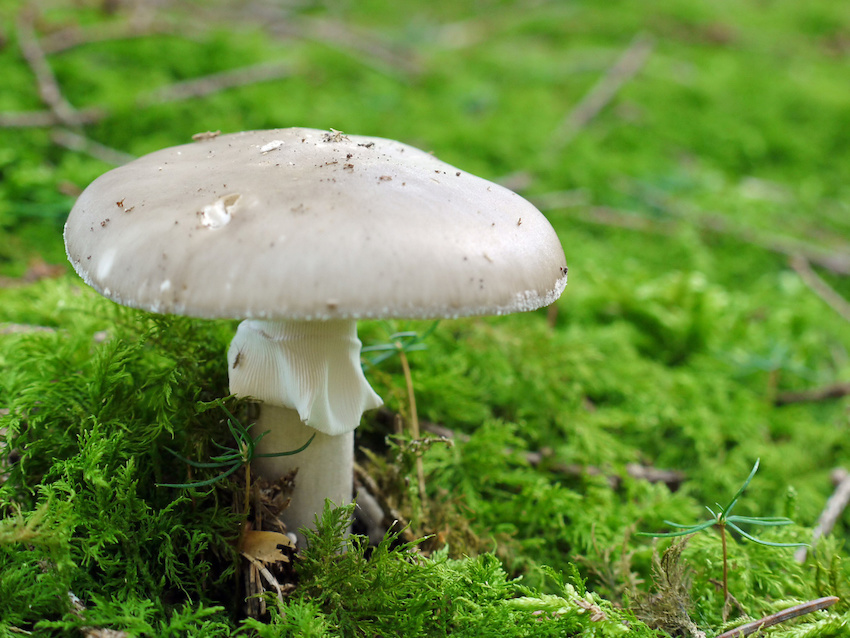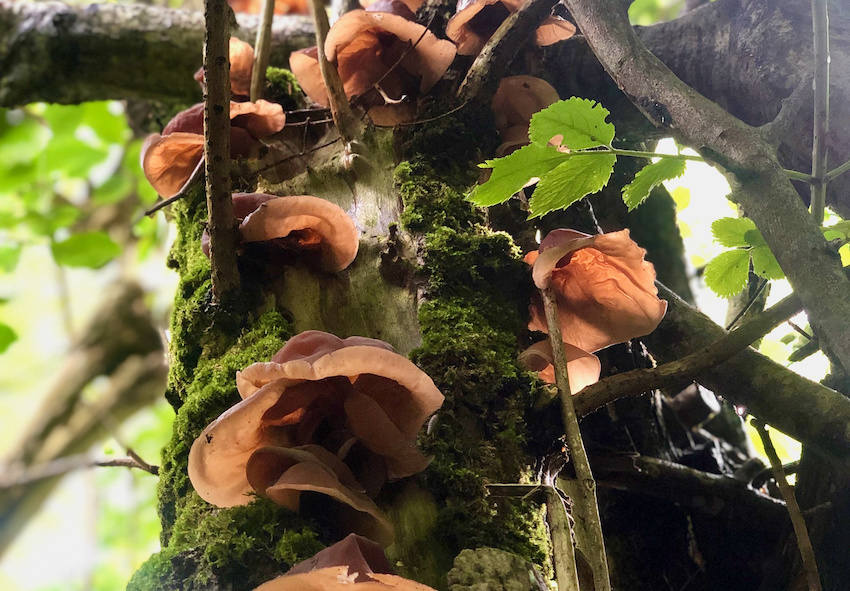
The Wild Path Of Foraging: A Journey Through The Seasons
Following is an exert from an essay written by Natural Physician student, Jemima Rose, on foraging through the seasons. I’ve included her section on winter foraging and will post each of the seasons from her essay, with her beautiful photos, over the course of the coming year. Jemima and her family have a wonderful passion for foraging and are currently working on a children’s book…which I can’t wait to read!
To one in sympathy with nature, each season, in turn, seems the loveliest. – Mark Twain
The Four Seasons
One of the many gifts that nature bestows upon us are the four seasons. With each change, we have the opportunity to attune to our surroundings, inviting the outside in – into our hearts.
The onset of the bleak winter doesn’t have to mean that we too, turn bleak in our outset – winter is an annual permission slip to slow down, to choose cosy nights by the fire, warming the kitchen by cooking up feasts, spending more time with family, working on projects ready to blossom come Spring.
Look to the beech and oak trees, who shed their leaves and turn to stillness. The squirrels, having built up their fat intake in Autumn, who spend the winter months sleeping in warm nests of leaves and moss.
And we have discovered another gift from nature – wild food! My family and I associate each season not only with the changing landscapes but with what is growing in the plant and fungi kingdom. A forager never forgets where they found wild food – every single discovery is etched into our hearts, and each year, when we return to our favourite spots, our feet will gladly guide us there.
When Autumn bursts bright with colour, we look to the leaf littered floor and spy fungi emerging in all shapes, colours and hues. From the exquisite amethyst deceiver to the coveted porcini mushroom, there is delight at every corner.
In Spring, when the first vibrant green shoots appear, we invite nature’s detox and joyfully cleanse the heaviness and slowness of the winter, to be reborn into the burgeoning Spring.
And with the summer comes a surge of energy, utilising the long, light days to roam the meadows and the forests for fistfulls of red clover, meadowsweet, mugwort and juicy fungi like chicken of the woods.
While many are familiar with the blackberries and apples of autumn, and the strawberries and raspberries of summer, few are aware of the delights hiding in plain sight along hedgerows, in wild meadows, within fields, atop hills and in the heart of woodlands – for these are the edible gems of the wild, and they are for only the eyes that take enough time to notice – if you don’t look, you won’t see!
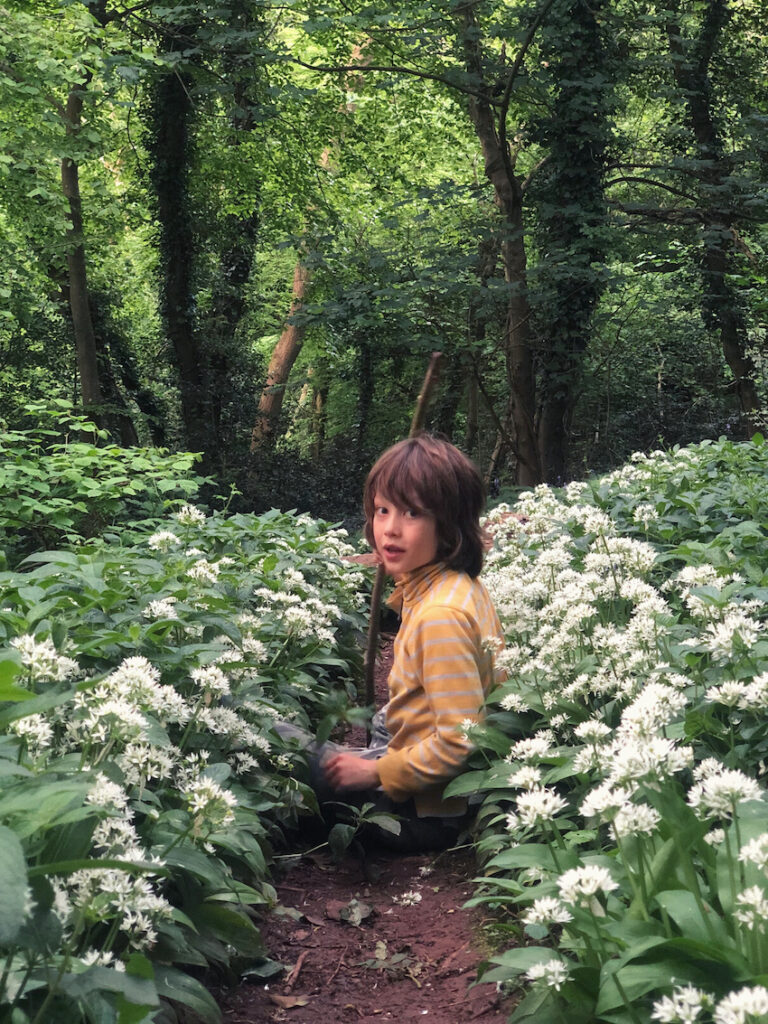
Wild food can transform countryside meanders, indeed, it can transform the seasons. And it can transform lives. Foraging has forever altered the way my family lives, breathes, walks and connects with nature.
No longer do we travel in a straight line from A to B. No longer do we dread trudging the wintery fields in the deep winter. For beauty is everywhere. And it is as much about the land as it is the wild food.
We know the month, the weather conditions and the habitat where we can meet our dearest mushroom friends, just like we understand the intricate partnership of the rose and the hawthorn, the porcini and the Oak.
It is a joy not to be underestimated. And so here I shall share how we attune to the seasons and what wonders await you, when you too, begin the insatiable practice of seasonal foraging.
I am sharing some of my favourite wild gems to look out for in winter – these are family favourites, with memories interwoven from experiences together, first-time discoveries, family feasts and more!
Winter Wonders
“Forget not that the earth delights to feel your bare feet and the winds long to play with your hair.” – Khalil Gibran
Velvet Shank / Flammulina velutipes
– Also known as Enoki Habitat: Dead stumps of deciduous trees, notably elm Month to harvest: Late autumn through winter
Such a joyous mushroom that appears long after the winter blewit has done its dash. Another reason we love this mushroom is because it is a beautiful orange colour – we will often be meandering through the woods and then stop to double take at a flash of orange amongst the brown – nearly always a generous flush of velvet shanks.
Interestingly, due to its high popularity and demand in Asia, velvet shank, (referred to as Enoki) is cultivated indoors to produce pure white, snowy specimens, rather than the orange type with black stems that we find here in the UK. The white colour occurs due to the lack of sunlight. (Which must surely mean less vitamin D in cultivated species!).
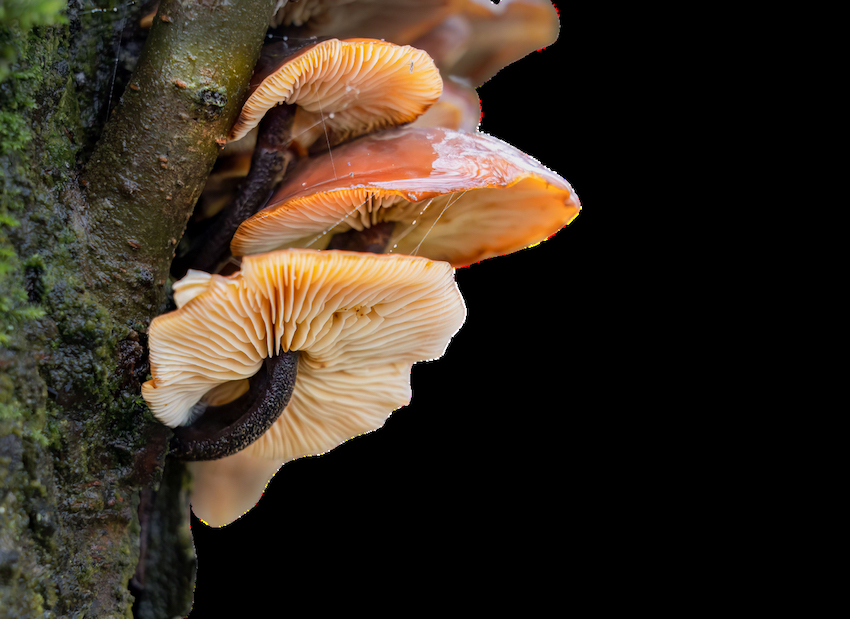
Health Properties of Velvet Shank / Enoki
Prescribed in traditional Chinese Medicine and widely enjoyed in Asian cuisine, Velvet Shank AKA Enoki, is a powerful medicinal mushroom due to its high antioxidant content. Eraly studies show promising results in treating cancer.
Velvet shank have a high protein to carb ratio(10:1) [4], and a particular protein lectin, help to promote the production of antioxidants, making it antiviral, antibacterial and generally a brilliant mushroom for supporting body-wide health and well-being. [4]
High levels of vitamin B, particularly vitamin B3, which helps to ease joint pain. Twice as much fibre as cabbage.
How to enjoy velvet shank.
Shanks have a slightly gelatinous slime on the exterior. Sounds horrid, but it actually washes off easily enough. And this is a very strong identification marker, along with their dark, velvety stem, although young specimens don’t always have this, so you need to know your other ID’s so as not to confuse them with their poisonous Funeral Bell, (deadly) and sulphur tuft (will make you severely sick). However, neither of these two toxic counterparts appear so late into winter as the velvet shank.
We’ll give them a quick wash or rub down with a kitchen towel or cloth, then enjoy sauteed in stews, sometimes along with jelly ear, too.
Final of Wild Foraging Essay
Oyster Mushrooms / Pleurotus ostreatus
Habitat: Dead wood, oak, beech.
Harvest Month: December to January
Just last night, my husband and son visited a decayed log, where every year, oysters grow, and believe me, they taste nothing like the shop bought version! We added to our curry, along with Wood Blewits.
We can take a 20 minute walk to where we know these special fungi grow. As soon as the first frosts descend in winter, we know it’s time to check our spot and keep an eye out for dead wood.
We will come home with a basket of the most delicious oysters ever! And my heart is always so full of joy and gratitude – not only for the feast but because we’re not spending money at supermarkets on plastic packaged, farmed mushrooms, that lack so many of the nutrients that wild mushrooms possess.
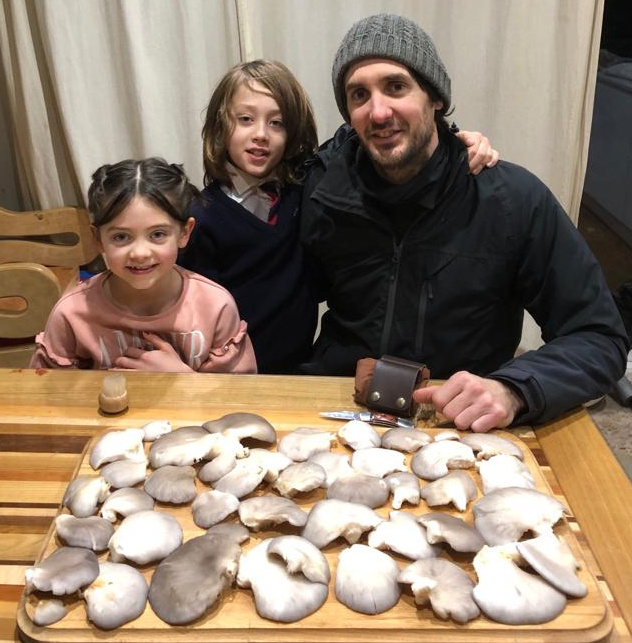
Health Properties of Oysters:
Oyster are high in protein, easy to digest, rich source of fibre, high mineral content and contain up to 20 percent beta-glucans. They also have immunomodulating effects, having been studied in small trials. Other animal studies show their ability to lower cholesterol and blood sugar levels. [3]
How We Enjoy Oysters:
As with most mushrooms, it is best to gently saute and without any oil, to let the water evaporate from them – oil and water do not mix! You can then add a little olive oil to the pan and fry on a low heat until crispy.
We often will make an oyster and blewit mushroom winter pie for our Christmas Day lunch!
Field and Wood Blewits / Clitocybe nuda
Habitat: Fields and woodlands
Harvest Month: November to December
Honestly, the sight of blewits, especially the exquisite looking wood blewits, is enough to make me cry. I saw my first few the other day, and my heart swelled with joy! It’s an actual physical feeling of my heart expanding in my chest – a warmth in my belly, a sight for sore eyes.
They are just the most beautiful creatures. A delicate purple – a colour you could never find with anything man-made.
They often grow in woodlands, as the name suggests, but we also stumble across them in fields, particularly at the edge of fields that are close to trees.
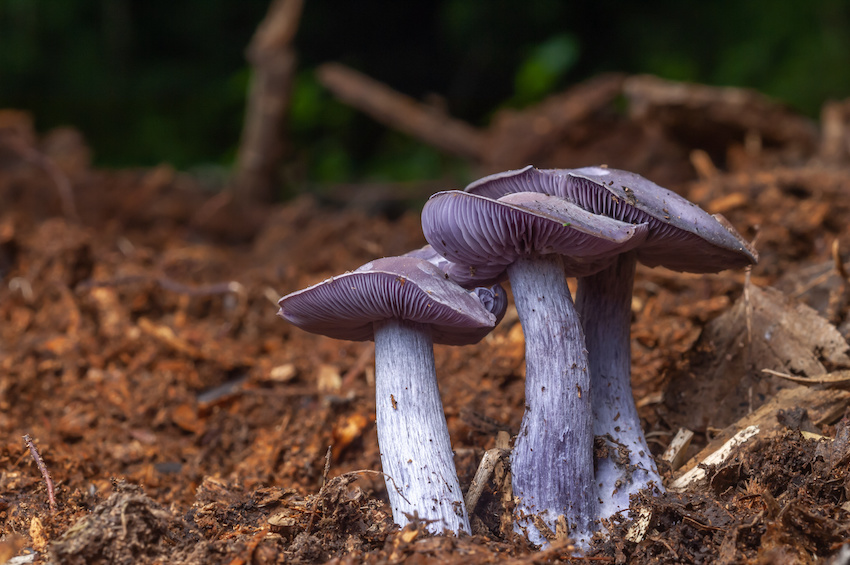
Health Properties of Blewits:
Wood blewit mushrooms, categorised as functional fungi for their health benefits, lack extensive research compared to other mushrooms.
Ongoing studies explore the antiangiogenic properties of C. nuda, showing promise in inhibiting tumour growth. An older study suggests potential antidiabetic and antihyperlipidemic effects. However, the limited human research emphasises the need for caution before considering blewit fungi for specific health conditions.
Enjoy them in moderation and for their nutritional content, being that they are low in calories, are a good source of protein and vitamin D. [11]
How We Enjoy Blewits:
Lightly sauteed, the flavour of the blewit is delicately released – we pair with garlic and a real treat is to enjoy on toast with lashings of olive oil! We also love these to garnish soup and stews.
Jelly Ear / Auricularia auricula-judae
Habitat: Dead elder trees, occasionally holly or other small trees Harvest Month: All year round
And they really do resemble ears! Jelly Ear are particularly dear to me, because my children get so much joy from them. They are perhaps an acquired taste, but Wilf and Arabella’s favourite meal is jelly ear stew.
I’ve grouped these as a winter find, but only because winter is when you find the least amount of wild edibles. Having said that, if it is exceptionally cold or dry, I do not recommend picking jelly ear as they shrivel up and lose their gelatinous quality.
Jelly ear most commonly grows on elder trees. I love this because it has helped me to identify and spot elder trees and then know to always check them for jelly ear.

Health Properties of Jelly Ear:
Jelly Ear or its more delicate Asian cousin, cloud ear, are widely used as medicine across Asia, Europe, New Zealand and Mexico. In TCM, they are known for building the blood [3] and are thought to help regulate menstrual flow, reduce haemorrhoids and relieve discomfort. Recent research also indicates cardiovascular benefits, in part due to its anticoagulant effects.
Jelly ear is high in fibre and is thought to contain prebiotics to aid digestion. The beta-glucan content of jelly ear has been shown to increase the response rate to chemotherapy in gastric cancers. [3]
Originally utilised solely in traditional medicine, this mushroom has attracted attention from researchers due to growing evidence supporting its health benefits, such as inhibiting the growth of cancer cells and reducing cholesterol levels. [5] They are high in antioxidants, rich in copper, and good sources of selenium, pantothenic acid, and riboflavin. [5]
How We Enjoy Jelly Ear
You can enjoy them fresh and dried – we dry and then rehydrate when needed. Or blitz to make a fine powder for stock.
Fun fact! If you lightly saute jelly ear, you need to watch out for flying saucers, as they can pop out of the pan, and not just a little hop, but a flying leap across the room! Magic. (And also perhaps a hazard!).
Forage Responsibly
We have a right to forage for wild food, however, there are instances where you will need to seek permission from the landowner. You are not entitled to dig up a plant unless you have permission. You must also take into consideration private land and landowners rights, such as the National trust have their own rules and rights for foraging.
Only pick what you need
Always leave most of what you find and harvest only what you need or will use. This is especially applicable to fungi – if we come across one or two, or only a very small or young patch, we will leave them to do their magical thing.
We also will collect from different patches – rather than stripping a patch of red clover bare, for example, we will pick sporadically across different meadows.
Sometimes, if abundant, we will harvest a large amount of chicken of the woods and then freeze it, as it is one of the few mushrooms that keeps well this way.
With porcini, we may find a big haul, and therefore we will dry and enjoy throughout the year.
Everything in moderation
Another note is that all wild plants should be consumed in a balanced way – none should be eaten in excess and it is important to vary what you eat day to day. You also don’t want to keep going back to just one patch – this is a wonderful opportunity to explore your local surroundings.
A LITTLE BIT OF KNOWLEDGE IS A DANGEROUS THING…
A note on wild mushrooms. There are, as you are likely aware, several species of highly toxic mushrooms, which, if ingested, can make you severely ill and can result in death. Let’s take the death cap, for example – which can be admired for its beauty and power, but left well alone!
I don’t mention this to put you off – although when we first started exploring wild food, I did say ‘never am I eating wild mushrooms’. Fast forward five years, and I’ve eaten over thirty different species!
BUT – we have never, ever picked something that we aren’t 100% certain of its identification. One forager, John Wright, author of River Cottage Handbook 01 – Mushrooms – said it took him 20 years to pluck up the courage to eat a mushroom called The Miller. This is because it looks so similar to the deadly Fools Funnel. He was 100% sure of its ID, of course – we won’t touch this particular ‘shroom.
And the same applies to certain plants. You have to put in the work of understanding and learning about not just the appearance of these plants and fungi, but their smell, their habitat, their partnership with other plants – where you find the Miller, you will often find porcini! Where you find a lush ring of grass, you may be treated to St George’s mushrooms. Where you see hawthorn berries, expect to see blackberries and rosehips.
It’s also useful to know what the similar toxic or inedible species are, so that you can get up close to these, and enhance the certainty of identification of the edibles.
Always triple check your ID from multiple sources, not just from the internet or from one book – but a combination. We frequent www.wildfood.co.uk, and have many great books – I recommend the Foragers Calendar and the River Cottage Mushrooms book, by John Wright.
Pictured – The deadly Deathcap
